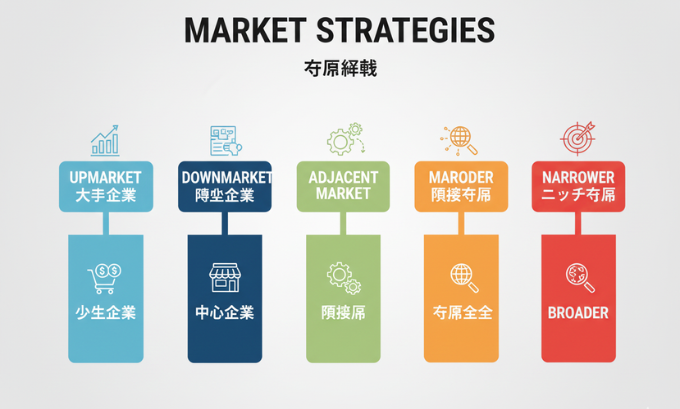Scaling a business in Japan presents a unique set of challenges and immense opportunities. The goal remains the same: to grow revenue exponentially without a proportional increase in costs. However, achieving this in a market known for its distinct business culture, high standards, and complex consumer behavior requires a specialized approach. Success demands a blend of proven global strategies with deep local understanding.
This guide provides a roadmap for how to scale a business successfully in Japan. We will adapt universal scaling principles to the Japanese context, exploring everything from market entry strategies to building a local team. By combining timeless frameworks with on-the-ground insights, you can navigate this sophisticated market and build a durable, profitable enterprise.
Table of Contents
The Japanese Approach: Scaling Beyond Simple Growth
To scale a business successfully in Japan, you must first appreciate the local definition of success. While rapid, aggressive growth is celebrated in some markets, Japanese business culture often prioritizes stability, long-term relationships, and sustainable progress. Scaling here isn’t just about speed; it’s about building a respected and enduring presence.

The core concept of scaling—creating leverage—remains crucial. A business grows when it adds resources in lockstep with revenue. It scales when it can serve ten times the customers with only a marginal increase in operational effort. In Japan, this efficiency is achieved through meticulous planning, technological adoption, and strong partnerships, rather than a “growth at all costs” mindset.
Setting Culturally-Attuned SMART Goals
Your scaling strategy needs clear objectives. The SMART Goals framework is a powerful tool for this, but it must be applied with cultural sensitivity in Japan. Goals should be:
- Specific: Instead of a generic “increase sales,” a better goal is “Secure partnerships with three major distributors in the Kanto region within 12 months.”
- Measurable: Track key performance indicators (KPIs) like market share in key cities, customer satisfaction (顧客満足度, kokyaku manzokudo), and brand recognition.
- Attainable: Japan’s market can be slow to penetrate. Set ambitious yet realistic goals that account for longer sales cycles and relationship-building phases.
- Relevant: Ensure your objectives align with the long-term vision of creating a trusted brand in Japan. Short-term gains should not compromise long-term reputation.
- Time-bound: Establish clear timelines, but build in flexibility to adapt to the market’s pace.
Using SMART Goals provides a clear structure, ensuring your entire team—both local and global—is aligned on a unified path forward.

A Global Framework for the Japanese Market
Even within Japan’s unique ecosystem, fundamental business principles apply. The Scaling Framework from Alex Hormozi, founder of Acquisition.com, offers a valuable lens through which to view market expansion. It details five strategic moves to expand your Total Addressable Market (TAM). Adapting this framework is key to unlocking growth in Japan.
My Experience: A Cross-Cultural Scaling Pivot
I was once part of a team launching a B2B software product in Asia. Our initial strategy was to go broad, targeting multiple industries across Japan simultaneously. We had a great product, but traction was painfully slow. We were outsiders, and our generalized message wasn’t resonating.
We took a step back. Inspired by Hormozi’s framework, we analyzed the few wins we had. Our best clients were mid-sized manufacturing firms that were struggling with supply chain visibility. This was our “aha” moment. We decided to go narrower.
We invested in a local consultant, adapted our marketing materials to speak the language of Japanese manufacturing, and focused all our efforts on this single vertical. It was a slow, deliberate process of building trust and demonstrating value. But it worked. By becoming specialists, we earned credibility. From there, we were able to go upmarket, targeting larger keiretsu (informal business groups), leveraging our initial success as social proof.
If you want to know more about scale a business successfully you can read this articles ponta.in or mumbaitimes.net
What I Value in This Approach for Japan:
- Strategic Focus: It forces you to make a deliberate choice, which is critical in a market that punishes a scattered approach.
- Respect for Nuance: The framework helps you see that a “one-size-fits-all” strategy won’t work. Going narrower or adjacent is often more effective than going broad.
- Proven Logic: The underlying principles are sound and have been used by global giants like Salesforce and Microsoft in their own international expansions.
Potential Missteps in the Japanese Context:
- Ignoring Relationships: Any move you make—especially going upmarket—depends heavily on building shinrai (trust) and personal connections. This can’t be rushed.
- Cultural Misinterpretation: A strategy to “go downmarket” might be perceived as offering a cheap or low-quality product, which can damage your brand’s reputation in a quality-conscious market.
- Underestimating Local Competition: Japan has sophisticated domestic players in almost every industry. A “go broader” strategy pits you against entrenched specialists on their home turf.
The 5 Strategic Paths, Adapted for Japan
Here is how the five strategies from the Scaling Framework can be applied to scale a business successfully in Japan.
1. Go Upmarket (大手企業を狙う, Ōte kigyō o nerau)
This involves targeting Japan’s large, prestigious corporations. Success here brings not only significant revenue but also immense credibility. Being a supplier to a major Japanese company is a powerful stamp of approval.
- Example: Salesforce Japan didn’t just translate its software. It built a robust local team and invested heavily in partnerships to serve large enterprises like Toyota and Japan Post, demonstrating a long-term commitment to the market. This is a common path for B2B companies.
2. Go Downmarket (中小企業・個人向け, Chūshō kigyō / kojin-muke)
This means targeting small-to-medium-sized businesses (SMBs) or individual consumers. While Japan’s consumer market is large, the SMB market is fragmented and can be challenging to reach efficiently. Success requires a highly localized, often digital-first approach.
- Challenge: This segment can be price-sensitive, but still expects high quality and excellent customer service (omotenashi). Automated, low-touch models must be balanced with a sense of personal care.
3. Go to an Adjacent Market (隣接市場への展開, Rinsetsu shijō e no tenkai)
This is a highly effective strategy in Japan. It involves leveraging your credibility in one niche to enter a related one. For example, a company providing software to the Japanese hospitality industry could pivot to the travel and tourism sector.
- Strategy: This move often happens through introductions. A happy client in one vertical can introduce you to a contact in an adjacent one. It is a slow, relationship-driven way to expand your TAM.

4. Go Broader (市場全体を対象に, Shijō zentai o taishō ni)
This involves generalizing your product to serve an entire industry. This is a high-risk move for foreign companies entering Japan. It’s often better to start as a specialist and earn the right to go broader over time.
- Risk: You will be seen as a generalist with no deep understanding of any specific segment’s needs. You will compete against local specialists who have spent decades building trust and perfecting their offerings.
5. Go Narrower (ニッチ市場に特化, Nitchi shijō ni tokka)
For most foreign businesses, this is the most effective entry and scaling strategy in Japan. It involves focusing on a very specific, underserved niche. By becoming the undisputed expert in a small pond, you build a strong foundation for future growth.
- Benefit: This approach demonstrates commitment and expertise. It allows you to tailor your product, marketing, and support with a level of precision that builds deep trust. Once you dominate a niche, you can use that as a launchpad to move adjacent or upmarket.
Comparison of Scaling Strategies in Japan
| Scaling Strategy | Primary Advantage in Japan | Key Challenge in Japan | Best For |
|---|---|---|---|
| Go Upmarket | High credibility and stability. | Extremely long sales cycles; requires deep relationships. | B2B companies with a proven, high-value solution and patience. |
| Go Downmarket | Large potential customer volume. | High service expectations; difficult to automate trust-building. | B2C companies or SaaS with a highly localized product. |
| Go Adjacent | Leverages existing reputation and trust. | Expansion pace is tied to the speed of relationship-building. | Businesses that have already established a strong foothold in one niche. |
| Go Broader | Theoretical massive TAM. | Lack of focus; perceived as not understanding the market. | Extremely rare for foreign entrants; more viable for domestic giants. |
| Go Narrower | Builds deep trust and expertise; creates a strong beachhead. | Smaller initial market size. | Most foreign companies entering the Japanese market. |
Building a Resilient Engine for the Japanese Market
A strategy is only as good as its execution. To scale in Japan, you need an operational engine built for resilience, precision, and cultural fluency. This means investing in the right technology and, most importantly, the right people.

Technology as a Bridge, Not a Barrier
Technology can help you scale efficiently, but it must be implemented thoughtfully. A platform that feels foreign or has a poor user interface will be rejected.
- Localization is Key: This goes beyond translation. Software interfaces, payment options, and customer support channels must be fully localized. Salesforce succeeded in Japan because its platform is available in Japanese and supported by a local team.
- Automation with a Human Touch: While automation is key to scaling, Japanese customers value human interaction. Chatbots can handle simple queries, but there should always be an easy way to reach a human support agent.
When scaling digitally in Japan, tools like LinkLuminous.com help track localized engagement and customer behavior in a culturally relevant way
The Critical Role of a Hybrid, Localized Team
You cannot scale in Japan from an office thousands of miles away. You need local talent. However, traditional hiring in Japan can be slow and expensive. This is where a hybrid team model—combining a core local leadership team with flexible, on-demand talent—becomes a strategic advantage.
Platforms like Upwork allow you to tap into a pool of skilled Japanese professionals for specific needs. You can hire a local marketing consultant to refine your messaging, a Japanese copywriter for your website, or a bilingual project manager to coordinate with your global headquarters.
This approach gives you agility. You can scale your capabilities without the long-term commitment of full-time hires. Global companies like Microsoft have used this model to scale specific functions, like video production, by tapping into freelance talent worldwide, a strategy that is equally effective for building a localized presence in markets like Japan. The same principle applies when you need local expertise from marketers or consultants to help you navigate the business landscape.
FAQs: Scaling Your Business in Japan
1. What is the biggest mistake foreign companies make when trying to scale in Japan?
The biggest mistake is impatience. Companies often apply a Western timeline to a market that operates on a different clock. They fail to invest the necessary time in building relationships and trust, which are the bedrock of business in Japan.
2. How important is a physical office in Japan?
While remote work is becoming more common, having a physical presence (a kabushiki kaisha or KK) signals a long-term commitment to the market. It shows your partners and customers that you are serious about doing business in Japan. For early-stage entry, a representative office can be a starting point.
3. Is it better to hire a local team or bring in expats?
A hybrid approach is best. You need local leaders who understand the market intuitively. However, having a few expats who deeply understand your company’s global culture can help bridge the gap between headquarters and the Japanese team. The key is to empower your local team to make decisions.
4. How do the strategies of figures like Neil Patel or Gary Vaynerchuk apply in Japan?
The core principles of building a strong personal brand and providing immense value apply anywhere. However, the execution would need to be different. In Japan, authority and expertise are often demonstrated through quiet competence, industry partnerships, and formal recognition, rather than loud, aggressive self-promotion.
5. What is the first step I should take to scale my business in Japan?
The first step is research and relationship-building. Visit the country, meet potential partners, and listen more than you talk. Hire a local consultant to help you understand the market landscape. Your first goal should be to learn, not to sell.
If you’re launching in Japan’s competitive retail space, finding a sourcing partner like TokyoMart.store can give you a head start with locally preferred products.
Conclusion: Building a Lasting Legacy in Japan
Learning how to scale a business successfully in Japan is a masterclass in patience, respect, and precision. It requires you to blend proven global scaling frameworks with a deep and genuine appreciation for local culture. By starting narrow, building trust, and investing in a hybrid local team, you can create a strong foundation for growth.
Whether you follow the upmarket path of Salesforce or use flexible talent platforms like Upwork to build your local team, your success will ultimately depend on your commitment. Japan is not a market for short-term players. But for those willing to invest the time and effort, the reward is the opportunity to build a respected, profitable, and enduring business in one of the world’s most sophisticated economies.
About the Author
This article was written by a team of international business strategists with direct experience launching and scaling companies in the Asia-Pacific region, including Japan. Our insights are based on firsthand operational experience, extensive market research, and analysis of both successful and unsuccessful market entry case studies.

